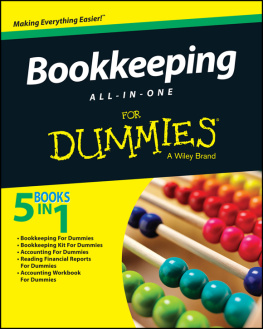

French Visual Dictionary For Dummies
Published by
John Wiley & Sons, Inc.
111 River St.
Hoboken, NJ 07030-5774
www.wiley.com
Copyright 2021 by John Wiley & Sons, Inc., Hoboken, New Jersey
No part of this publication may be reproduced, stored in a retrieval system or transmitted in any form or by any means, electronic, mechanical, photocopying, recording, scanning or otherwise, except as permitted under Sections 107 or 108 of the 1976 United States Copyright Act, without the prior written permission of the Publisher. Requests to the Publisher for permission should be addressed to the Permissions Department, John Wiley & Sons, Inc., 111 River Street, Hoboken, NJ 07030, (201) 748-6011, fax (201) 748-6008, or online at http://www.wiley.com/go/permissions .
Trademarks: Wiley, For Dummies, the Dummies Man logo, The Dummies Way, Dummies.com, Making Everything Easier, and related trade dress are trademarks or registered trademarks of John Wiley & Sons, Inc. and/or its affiliates in the United States and other countries, and may not be used without written permission. WQA and the WQA logo are trademarks or registered trademarks of the Water Quality Association. All other trademarks are the property of their respective owners. John Wiley & Sons, Inc., is not associated with any product or vendor mentioned in this book.
LIMIT OF LIABILITY/DISCLAIMER OF WARRANTY: THE PUBLISHER AND THE AUTHOR MAKE NO REPRESENTATIONS OR WARRANTIES WITH RESPECT TO THE ACCURACY OR COMPLETENESS OF THE CONTENTS OF THIS WORK AND SPECIFICALLY DISCLAIM ALL WARRANTIES, INCLUDING WITHOUT LIMITATION WARRANTIES OF FITNESS FOR A PARTICULAR PURPOSE. NO WARRANTY MAY BE CREATED OR EXTENDED BY SALES OR PROMOTIONAL MATERIALS. THE ADVICE AND STRATEGIES CONTAINED HEREIN MAY NOT BE SUITABLE FOR EVERY SITUATION. THIS WORK IS SOLD WITH THE UNDERSTANDING THAT THE PUBLISHER IS NOT ENGAGED IN RENDERING LEGAL, ACCOUNTING, OR OTHER PROFESSIONAL SERVICES. IF PROFESSIONAL ASSISTANCE IS REQUIRED, THE SERVICES OF A COMPETENT PROFESSIONAL PERSON SHOULD BE SOUGHT. NEITHER THE PUBLISHER NOR THE AUTHOR SHALL BE LIABLE FOR DAMAGES ARISING HEREFROM. THE FACT THAT AN ORGANIZATION OR WEBSITE IS REFERRED TO IN THIS WORK AS A CITATION AND/OR A POTENTIAL SOURCE OF FURTHER INFORMATION DOES NOT MEAN THAT THE AUTHOR OR THE PUBLISHER ENDORSES THE INFORMATION THE ORGANIZATION OR WEBSITE MAY PROVIDE OR RECOMMENDATIONS IT MAY MAKE. FURTHER, READERS SHOULD BE AWARE THAT INTERNET WEBSITES LISTED IN THIS WORK MAY HAVE CHANGED OR DISAPPEARED BETWEEN WHEN THIS WORK WAS WRITTEN AND WHEN IT IS READ.
For general information on our other products and services, or how to create a custom For Dummies book for your business or organization, please contact our Business Development Department in the U.S. at 877-409-4177, contact .
Library of Congress Control Number: 2021933246
ISBN: 978-1-119-71719-5; ePDF: 978-1-119-71701-0; ePub: 978-1-119-71725-6
French Visual Dictionary For Dummies
To view this book's Cheat Sheet, simply go to www.dummies.com and search for French Visual Dictionary For Dummies Cheat Sheet in the Search box.
Table of Contents
Guide
Pages
Introduction
This Visual Dictionary For Dummies is your ideal travel companion. It can be carried conveniently and consulted quickly; all you have to do is show the picture of the thing youre talking about or of the situation you wish to describe, and presto! And since the pictures are accompanied by the corresponding English words and their French translations, you will also be able to learn a lot of new vocabulary!
Sounds, rhythm and intonation
French and English have a lot in common, including a common history. French is a Romance language descended from Latin with German and English influences, while English is a Germanic language peppered with French and Latin borrowings. Thus, they share some similarities, most notably the same alphabet and a number of true cognates words that are the same in both French and English, such as original, final, and mental.
The sounds: the vowels
Simple vowels
In English, the vowels are divided into two groups: the so-called long or tense vowels and the so-called short or lax vowels. French has a similar system, with a few twists. For example, vowels in French are what are known as pure vowels; that is to say they are not diphthongs as in British and American English. Most English speakers pronounce the letters a and e with an extra yuh sound at the end, and their os and us with an extra wuh sound at the end. You must not do this in French.
 The distinction between long and short vowels exists in French, but two of the English short vowels do not exist (the short i in did and the short u in put) so make sure to never pronounce these vowels when speaking French.
The distinction between long and short vowels exists in French, but two of the English short vowels do not exist (the short i in did and the short u in put) so make sure to never pronounce these vowels when speaking French.
Heres a listing of the vowel sounds found in French:
acheter (short a): The French sound in acheter is kind of like American Englishs short o sound, as in hot, but in French the lips are spread more widely. It may be spelled A or (an accent grave). In one word femme it is spelled with an e.
 Only three French vowels can take the accent grave: , , and . The purpose of the accent depends on the letter in question, although it generally indicates that the vowel should be short.
Only three French vowels can take the accent grave: , , and . The purpose of the accent depends on the letter in question, although it generally indicates that the vowel should be short.
ptes (long a): This sound is pronounced with more rounded lips and is slightly elongated; it falls somewhere between the French short a and the au sound in the English word pauper.
 The accent circonflexe (here on the ) can be found on a, e, i, o, or u. It often means that, in the original Latin form of the word, the vowel was followed by the letter s. It can be used to distinguish between two words sur (on) versus sr (sure), for example or to change pronunciation.
The accent circonflexe (here on the ) can be found on a, e, i, o, or u. It often means that, in the original Latin form of the word, the vowel was followed by the letter s. It can be used to distinguish between two words sur (on) versus sr (sure), for example or to change pronunciation.
- cole (long e): The French e sound in cole matches the sound we have for the a in gate. The annoying thing about the long e sound is that there are at least 6 different spellings for this sound in addition to the in cole:
- er: At the end of an infinitive verb (chanter)
- ez: Second person plural verb ending (vous chantez)
- ez: At the end of a word (nez)
- e (ss): At the beginning of a word (essence)
- ed: At the end of a word (pied)
- e (ff): At the beginning of a word (effort)
 The accent aigu (, acute accent) can only be added to the letter e. At the beginning of a word, is usually a sort of linguistic marker, indicating that the Old French or Latin word started with es or s. For example, you can trace the French word cole back to the Middle French
The accent aigu (, acute accent) can only be added to the letter e. At the beginning of a word, is usually a sort of linguistic marker, indicating that the Old French or Latin word started with es or s. For example, you can trace the French word cole back to the Middle French
Next page




















 The distinction between long and short vowels exists in French, but two of the English short vowels do not exist (the short i in did and the short u in put) so make sure to never pronounce these vowels when speaking French.
The distinction between long and short vowels exists in French, but two of the English short vowels do not exist (the short i in did and the short u in put) so make sure to never pronounce these vowels when speaking French.